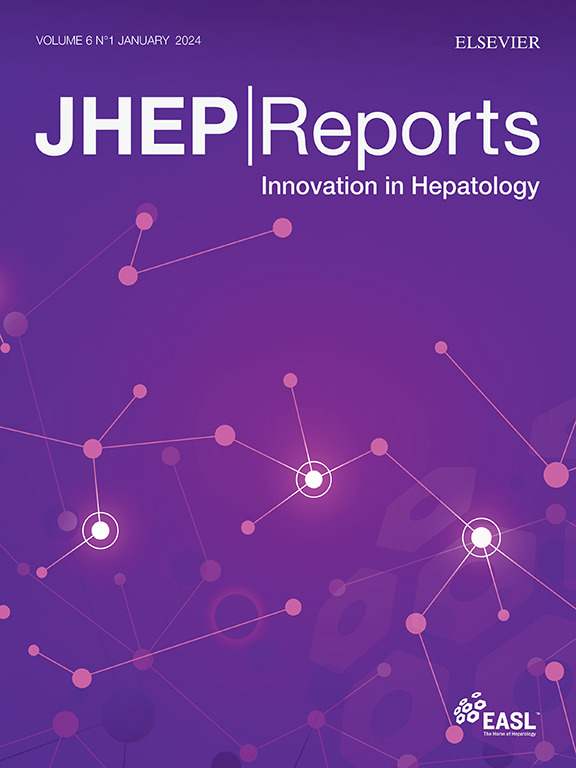肝细胞癌患者放射治疗后分期转移与总生存率之间的关系
IF 9.5
1区 医学
Q1 GASTROENTEROLOGY & HEPATOLOGY
引用次数: 0
摘要
背景,目的立体定向放射治疗(SBRT)和经动脉放射栓塞(TARE)是治疗肝细胞癌(HCC)的常用局部治疗方法。然而,缺乏替代终点限制了进行比较有效性临床试验的可行性。方法:我们对2008年至2019年间接受SBRT或TARE作为初始治疗的成年HCC患者进行了一项多中心回顾性队列研究。我们排除了巴塞罗那临床肝癌(BCLC) D期患者。主要结局是总生存,移植是一个竞争风险。感兴趣的自变量是在治疗6个月内转移到更晚期的BCLC期(例如BCLC期B→C)。使用Kaplan-Meier完成生存分析,并使用多变量Cox比例风险模型确定生存预测因子。结果纳入257例患者,中位年龄65岁;77%是男性,66%是白人。大多数(75%)患有Child-Pugh A级肝硬化。45例(18%)患者在6个月内出现分期转移。在接受SBRT或TARE治疗的6个月内经历分期转移的患者的生存期明显短于没有分期转移的患者(中位192天[IQR 108-397天])中位vs. 1259天[IQR 591 - 2135天];p & lt; 0.001)。在多变量分析中,分期迁移与较差的生存率显著相关(风险比:5.1,95% CI: 4.3-6.0),然而,分期迁移与生存率之间的相关性不足以用于代孕。结果在独立的外部验证队列和相关的亚组分析中是一致的。结论:肝癌患者接受SBRT或TARE治疗后6个月的分期迁移与总生存率相关。影响和意义接受肝细胞癌(HCC)治疗的患者的分期迁移是肿瘤功能、功能状态和肝功能的多方面指标。在这项研究中,我们能够证明在接受放射治疗的6个月内恶化的巴塞罗那诊所肝癌分期与总生存率有关。分期迁移可以作为未来肝细胞癌放疗患者临床试验的终点进一步探讨。本文章由计算机程序翻译,如有差异,请以英文原文为准。
The association between stage migration and overall survival after radiation-based therapies in patients with hepatocellular carcinoma
Background & Aims
Stereotactic body radiation therapy (SBRT) and transarterial radioembolization (TARE) are common locoregional therapies for hepatocellular carcinoma (HCC). However, lack of surrogate endpoints has limited the feasibility of conducting comparative effectiveness clinical trials.
Methods
We conducted a multicenter retrospective cohort study of adult patients with HCC who received SBRT or TARE as initial treatment between 2008 and 2019. We excluded those with Barcelona Clinic Liver Cancer (BCLC) stage D disease. The primary outcome was overall survival, with transplantation as a competing risk. The independent variable of interest was stage migration to a more advanced BCLC stage (e.g. BCLC stage B → C) within 6 months of treatment. Survival analysis was completed using Kaplan–Meier, and multivariable Cox proportional hazard models were used to identify predictors of survival.
Results
We included 257 patients with a median age of 65 years; 77% male and 66% White. Most (75%) had Child–Pugh class A cirrhosis. Stage migration within 6 months was observed in 45 (18%) patients. Patients who experienced stage migration within 6 months of receiving SBRT or TARE had significantly shorter survival than those without stage migration (median 192 days [IQR 108–397 days]) median vs. 1,259 days [IQR 591–2,135 days], respectively; p <0.001). In multivariable analysis, stage migration was significantly associated with worse survival (hazard ratio: 5.1, 95% CI: 4.3–6.0), however the correlation between stage migration and survival was not sufficient for surrogacy. The results were consistent in an independent external validation cohort and in relevant subgroup analyses.
Conclusions
Stage migration at 6 months is associated with overall survival in patients with HCC undergoing SBRT or TARE.
Impact and implications
Stage migration in patients with receiving hepatocellular carcinoma (HCC) treatment is a multi-faceted measure of tumor function, functional status, and liver function. In this study we were able to show that worsening Barcelona Clinic Liver Cancer stage within 6 months of receipt of radiation treatment is associated with overall survival. Stage migration could be further explored as an endpoint in future clinical trials in patients with HCC receiving radiation therapies.
求助全文
通过发布文献求助,成功后即可免费获取论文全文。
去求助
来源期刊

JHEP Reports
GASTROENTEROLOGY & HEPATOLOGY-
CiteScore
12.40
自引率
2.40%
发文量
161
审稿时长
36 days
期刊介绍:
JHEP Reports is an open access journal that is affiliated with the European Association for the Study of the Liver (EASL). It serves as a companion journal to the highly respected Journal of Hepatology.
The primary objective of JHEP Reports is to publish original papers and reviews that contribute to the advancement of knowledge in the field of liver diseases. The journal covers a wide range of topics, including basic, translational, and clinical research. It also focuses on global issues in hepatology, with particular emphasis on areas such as clinical trials, novel diagnostics, precision medicine and therapeutics, cancer research, cellular and molecular studies, artificial intelligence, microbiome research, epidemiology, and cutting-edge technologies.
In summary, JHEP Reports is dedicated to promoting scientific discoveries and innovations in liver diseases through the publication of high-quality research papers and reviews covering various aspects of hepatology.
 求助内容:
求助内容: 应助结果提醒方式:
应助结果提醒方式:


